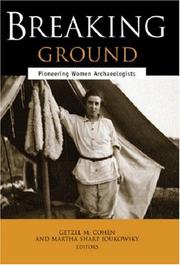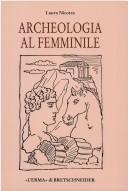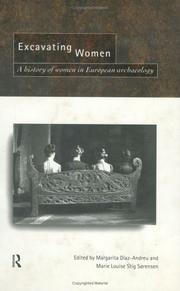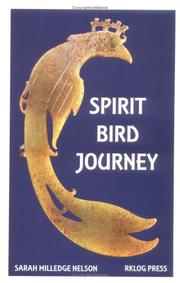| Listing 1 - 10 of 28 | << page >> |
Sort by
|

ISBN: 9780472031740 9780472113729 9780472025367 0472025368 1282639048 9786612639043 Year: 2004 Publisher: Ann Arbor : University of Michigan Press,
Abstract | Keywords | Export | Availability | Bookmark
 Loading...
Loading...Choose an application
- Reference Manager
- EndNote
- RefWorks (Direct export to RefWorks)
Biographies of twelve often-overlooked woman archaeologists.

ISBN: 888265284X 9788882652845 Year: 2004 Publisher: Roma: L'Erma di Bretschneider,
Abstract | Keywords | Export | Availability | Bookmark
 Loading...
Loading...Choose an application
- Reference Manager
- EndNote
- RefWorks (Direct export to RefWorks)

ISBN: 0415157609 Year: 1998 Publisher: London ; New York Routledge
Abstract | Keywords | Export | Availability | Bookmark
 Loading...
Loading...Choose an application
- Reference Manager
- EndNote
- RefWorks (Direct export to RefWorks)
Women archaeologists --- Europe --- History --- Archaeology

ISBN: 0967579805 Year: 1999 Publisher: Littleton, CO : RKLOG Press,
Abstract | Keywords | Export | Availability | Bookmark
 Loading...
Loading...Choose an application
- Reference Manager
- EndNote
- RefWorks (Direct export to RefWorks)
In deze fictieromn vertelt Sarah Nelson ons het verhaal van Clara, een Koreaans-Amerikaanse archeologe, die een opgraving doet in haar voorouderlijk thuisland. We lezen de ervaringen van Clara als veldarcheologe en als jonge vrouw gevangen tussen twee culturen, en Nelson vertelt ook het verhaal van Flyingbird en de neolithische mensen die in de heuvel woonden die Clara aan het opgraven is. Het boek behandelt onderwerpen als gender, sjamanisme, etnische identiteit en neolithische cultuur en is geschreven door een vooraanstaande Amerikaanse archeoloog die gespecialiseerd is in deze onderwerpen.
Book
ISBN: 9783830928720 3830928726 Year: 2013 Publisher: Münster ; New York : Waxmann,
Abstract | Keywords | Export | Availability | Bookmark
 Loading...
Loading...Choose an application
- Reference Manager
- EndNote
- RefWorks (Direct export to RefWorks)
Women archaeologists --- Femmes archéologues --- Biography --- Biographie
Book
ISBN: 9781803276137 1803276134 Year: 2023 Publisher: Oxford : Archaeopress,
Abstract | Keywords | Export | Availability | Bookmark
 Loading...
Loading...Choose an application
- Reference Manager
- EndNote
- RefWorks (Direct export to RefWorks)
An edited collection of letters that Karen D. Vitelli wrote from pre-EU Greece and Turkey to family during her later years of graduate school and early field work (at Franchthi Cave, Gordion, and a training session at Corinth) through to the completion of writing her dissertation in Athens during a coup (1968-1974).
Women archaeologists --- Archaeologists --- Vitelli, Karen D.
Book
ISBN: 3030875202 3030875199 Year: 2022 Publisher: Cham, Switzerland : Springer,
Abstract | Keywords | Export | Availability | Bookmark
 Loading...
Loading...Choose an application
- Reference Manager
- EndNote
- RefWorks (Direct export to RefWorks)
This book explores the uncharted territory of the history of archaeology under Communism through the biographies of five women archaeologists from the Soviet Union, Bulgaria, Romania, Hungary, and Poland. They were working in medieval archaeology, with a specific focus on the (early) Slavs. The choice of specialists in medieval archaeology has much to do with the fact that in the five East European countries considered in this book, medieval archaeology began to develop into a serious discipline less than a century ago. The main catalyst for the sudden rise of medieval archaeology was a dramatic shift in emphasis from traditional political and constitutional to social and economic history. In five countries, the rise of medieval archaeology thus coincides in time, and was ultimately caused by the imposition of Communist regimes. The five women were therefore true pioneers in their field, and respective countries. Florin Curta is Professor of Medieval History and Archaeology at the University of Florida, USA. His books include The Making of the Slavs (2001) and Slavs in the Making (2021). He is also the editor of several collections of studies. His most recent book is The Long Sixth Century in Eastern Europe (2021). Iurie Stamati teaches Historiography at the University of Quebec at Rimouski (Universite du Quebec a Rimouski), Canada. His research focuses on the political instrumentalization of history and archaeology in Eastern Europe. He is the author of several articles and of The Slavic Dossier: Medieval Archaeology in the Soviet Republic of Moldova Between State Propaganda and Scholarly Endeavor (2019)
Women archaeologists --- Archaeology, Medieval --- Antiquities, Medieval --- Medieval antiquities --- Medieval archaeology --- Archaeologists --- Women archaeologists. --- Archaeology, Medieval.
Book
ISBN: 9783458357315 3458357319 Year: 2010 Publisher: Frankfurt am Main : Insel,
Abstract | Keywords | Export | Availability | Bookmark
 Loading...
Loading...Choose an application
- Reference Manager
- EndNote
- RefWorks (Direct export to RefWorks)
Lesbians --- Lesbians. --- Women archaeologists --- Women archaeologists. --- Women authors, German --- Women authors, German. --- Mertens-Schaaffhausen, Sibylle, --- Schopenhauer, Adele, --- 1800-1899. --- Germany.
Book
ISBN: 9170618054 9170613052 Year: 2021 Publisher: Gothenburg Kriterium
Abstract | Keywords | Export | Availability | Bookmark
 Loading...
Loading...Choose an application
- Reference Manager
- EndNote
- RefWorks (Direct export to RefWorks)
Olov Janse was an archaeologist with a remarkable life. From his birth in Sweden 1892 to his death in the United States 1985, he travelled several times across the world and was present in some of the most important episodes of 20th century world history. His works and networks connected museums and political institutions in Sweden, France, Vietnam and the United States: from the Swedish History Museum, the Museum of Far Easter Antiquities, the French Musée d’antiquites nationales, the Cernuchi museum, and the French research institute EFEO in Hanoi, to UNESCO, the Harvard Peabody Museum, the Smithsonian Institution, and the U.S. Department of State. He left behind artefacts and documents in museum collections and archives across the world. But his name is largely unknown, and his most important contributions – the connection of people and ideas between continents and contexts – have remained invisible in historical accounts of all these institutions. He was, in every sense, an archaeologist in-between. This book follows in the footsteps of Olov Janse and his wife Renée, as they move between continents and contexts, connecting key actors and institutions in social and professional networks across the world. It tells the formidable story of an archaeologist navigating through world politics, from a late 19th century industrial town in Sweden, to early 20th century Parisian museums, to French Indochina and the Philippines in the 1930s, to the formation of UNESCO in 1946, and ending with public diplomacy for the U.S. Department of State at the verge of the Vietnam War.
Women archaeologists. --- Archaeologists --- Olov Janse --- UNESCO --- Archaeology --- OSS --- History museums --- Indochina
Book
ISBN: 9783805340632 380534063X Year: 2009 Publisher: Mainz : Zabern,
Abstract | Keywords | Export | Availability | Bookmark
 Loading...
Loading...Choose an application
- Reference Manager
- EndNote
- RefWorks (Direct export to RefWorks)
Archaeologists --- Women archaeologists --- Archaeology --- Archéologues --- Femmes archéologues --- Archéologie --- Biography. --- History. --- Biographies --- Biographie --- Histoire
| Listing 1 - 10 of 28 | << page >> |
Sort by
|

 Search
Search Feedback
Feedback About UniCat
About UniCat  Help
Help News
News